KELOWNA, B.C.--It needs to be said, from time to time: It isn't heat that ripens grapes, it's light. The engine that powers plants isn't hot air, but photosynthesis.
And so it is that the best wine-growing country in North America could well turn out to be the Okanagan Valley of British Columbia, where long hours of the most intense sunlight in North America (during the growing season) provide ripening power for classic grape varieties. At 50 degrees N, it's at the same latitude as the heart of Germany's Rheingau, and even further north than Champagne -- a freakish accident in the crumpled geology of the Cascades that created a unique string of protected valleys from Vernon (at the northern end of Lake Okanagan) 100 miles south to Osoyoos on the US border.
I first traveled to the Okanagan 30 years ago, when there were barely a dozen wineries, most making wine from cultivars and hybrids, to research my Northwest Wine Country series of guidebooks. At the time I came to the reluctant conclusion that the quality of the wines did not merit their inclusion in the book. But after the transition to vinifera grapes 20 years ago, the situation has changed markedly, and this year I accepted the offer of the Thompson Okanagan Tourism Association and the Okanagan Wine Festivals Society to return.
What I found was not unlike Oregon and Washington's wine country in the 1980s: Great enthusiasm on the part of the winemakers, and pride in the potential of a growing industry. On the American side of the border, wine enthusiasts of the '80s would bemoan the lack of facilities (hotels, resorts, restaurants) dedicated to tourism ("The Yakima Valley is maybe 25 years behind Napa," they would say.) But here in the Okanagan, the tourism infrastructure is already in place; if anything, vineyards must compete with vacation homes for the most desirable bench lands. And the wines -- bright Rieslings, elegant Pinot Noirs, rich Syrahs -- show high levels of technical accomplishment.
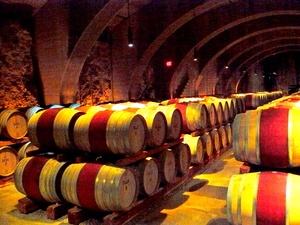 In Vancouver, Brian Storen, Canada's 2005 sommelier of the year (and poet laureate of the Kingdom of Bacchus), waxes lyrical about Okanagan wines. He is probably the only person to use the terms "sweaty bovine," "post-coital," and "necrotic" in the same sentence to discuss a wine, and he does it with the ease of arpeggios falling from Mozart's fingers. (That was in reference to a Malbec from Kettle Valley Vineyards). Talking about BC wines in general, Storen riffs in another dimension -- a whirlwind of free-association, Gerard Manley Hopkins, William Blake, and Jack Kerouac all at once: "earth, bramble and spice olfactory escalator's ascendance into gossamer strands of first crushed carnations then blackberry and melted purple crayon sylphs riding bareback through a heaving pack of saddle-mounted black currant." (Take that, Robert Parker!)
In Vancouver, Brian Storen, Canada's 2005 sommelier of the year (and poet laureate of the Kingdom of Bacchus), waxes lyrical about Okanagan wines. He is probably the only person to use the terms "sweaty bovine," "post-coital," and "necrotic" in the same sentence to discuss a wine, and he does it with the ease of arpeggios falling from Mozart's fingers. (That was in reference to a Malbec from Kettle Valley Vineyards). Talking about BC wines in general, Storen riffs in another dimension -- a whirlwind of free-association, Gerard Manley Hopkins, William Blake, and Jack Kerouac all at once: "earth, bramble and spice olfactory escalator's ascendance into gossamer strands of first crushed carnations then blackberry and melted purple crayon sylphs riding bareback through a heaving pack of saddle-mounted black currant." (Take that, Robert Parker!)
The word Okanagan means "meeting place" in the local Salish dialect. Halfway along the eastern shore of Okanagan Lake sits the region's biggest city Kelowna (pop. 100,000) with a spiffy international airport that's midway between Calgary and Vancouver. What used to be a sleepy valley dotted with motor courts that happened to grow juicy apricots is now all lakefront condos and glitzy resorts, vying with 10,000 acres of vineyards and dozens of "destination" wineries featuring gourmet dining.
It's a transformation that has taken place virtually overnight. The provincial tourism ministry has pounced on the phenomenal growth of tourism, pouring money into promotion of the Okanagan. The wine tourism industry itself has mounted the Okanagan Wine Festivals Society, which now involves over 100 wineries in four seasonal promotions that will produce 160 individual events this fall alone. Examples include "Pop Goes the Cork," "Battle of the Benches," and "All You Need is Cheese (and Wine)," in addition to bicycle races and mixology contests. To counter what might be termed tourism malaise, the Festivals Society has created sponsorship and partnership opportunities with local hotels, restaurants, banks, and transportation companies.
Still, if not for NAFTA, Okanagan would still be a minor player in the world of wine. After the trade act was passed in 1988, Canada could no longer put up trade barriers to protect its domestic products -- including wine. The modest-to-inferior wines produced from hybrid grapes were no match for California's Chardonnays and Merlots. Canadian winemakers needed a change. But how fast could the Okanagan come up with vinifera grapes and how good would the wines be?
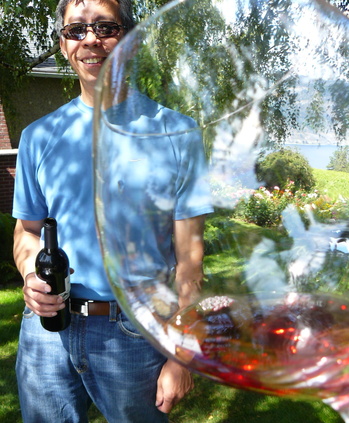 Enter Howard Soon. Soon, a Vancouver native, trained as a biochemist and worked for the Labatt Brewing Company for five years before moving to the Okanagan in 1980 and switching to wine. Working closely with the vineyard owners and managers, he played a leading role in the changeover to vinifera grapes, and, for the past 15 years, has been the master winemaker for a prestigious group that includes Sandhill -- Canada's 2009 winery of the year -- and Andrew Peller Ltd.
Enter Howard Soon. Soon, a Vancouver native, trained as a biochemist and worked for the Labatt Brewing Company for five years before moving to the Okanagan in 1980 and switching to wine. Working closely with the vineyard owners and managers, he played a leading role in the changeover to vinifera grapes, and, for the past 15 years, has been the master winemaker for a prestigious group that includes Sandhill -- Canada's 2009 winery of the year -- and Andrew Peller Ltd.
After growers pulled out their hybrids and labruscas in a government-subsidized renovation program in the late 1980s, the industry was down to 800 acres. "It was a steep learning curve," says Soon. "What works in France, Italy, California, and New Zealand doesn't necessarily work here." Fortunately, there was already a well-equipped agricultural research station on hand, at Summerland, funded by a $10 per ton assessment on BC grapes. Within 20 years, vineyard acreage had grown to 11,000 acres.
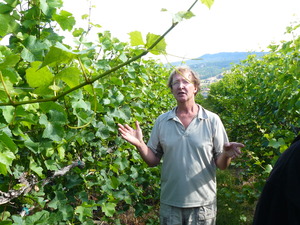 Soon makes some of his best wine from grapes grown on the spectacular 43-acre King Family Vineyard on the Naramata Bench. Brothers Don and Rod King use a remarkable trellis system developed in southern Oregon by Scott Henry -- an aeronautical engineer who 40 years ago turned his family's bottom land on the Umpqua River into a pioneering vineyard. Henry's trellising system, which increases light exposure on the leaves and fruit, and literally doubles yields per vine without sacrificing quality, is known worldwide as the Double Scott Henry.
Soon makes some of his best wine from grapes grown on the spectacular 43-acre King Family Vineyard on the Naramata Bench. Brothers Don and Rod King use a remarkable trellis system developed in southern Oregon by Scott Henry -- an aeronautical engineer who 40 years ago turned his family's bottom land on the Umpqua River into a pioneering vineyard. Henry's trellising system, which increases light exposure on the leaves and fruit, and literally doubles yields per vine without sacrificing quality, is known worldwide as the Double Scott Henry.
"You can't do this on lighter soils," says Don King, "but we plant 680 vines per acre here instead of 1,400 and get yields of 8 to 9 tons per acre instead of 4 tons." The downside of the system is that it's labor-intensive, requiring eight passes by vineyard crews in the course of a growing season.
Like any "emerging" region, the Okanagan has its pioneers, and since it's a young industry, the pioneers are still around, still active.
The most influential figure in British Columbia's ascendance is Harry McWatters who, 30 years ago this summer, founded Sumac Ridge in Summerland, on an east-facing bluff overlooking Lake Okanagan. He'd been director of marketing for Casabello, an outfit known in Canada as a "Commercial Winery," and when the Province created a new category -- "Estate Winery" -- McWatters and his business partner Lloyd Schmidt snagged the first license. The principal requirements: At least 20 acres of vineyards and wine made from your own grapes. McWatters wasn't the wine maker, he was the business man who led Sumac Ridge through a number of firsts -- among them the first bottle-fermented sparkling wine in Canada (Stellar's Jay Brut, in 1987).
Still, McWatters is even better known as the instigator of the Vintners Quality Alliance. Simultaneously an industry group and a standard of quality, the VQA began as a voluntary declaration of quality. Now it's an official designation on a bottle of wine certifying that the grapes are from British Columbia and that the wine has passed a blind taste test, like the AOC wines of France.
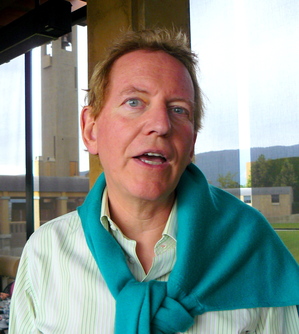 The closest thing British Columbia has to a wine superstar is Anthony von Mandl. Born in Canada to European parents, von Mandl attended schools in Switzerland, Austria, and Germany. Armed with an economics degree from the University of British Columbia, he apprenticed in the wine trade and, at age 22, launched his own wine import company -- Marc Antony. Resoundingly successful as a merchant, von Mandl proceeded to purchase Mission Hill. In the midst of the 1992 harvest, he hired New Zealander John Simes, as wine maker. One of the first wine Simes produced, labelled Mission Hill Grand Reserve Chardonnay, won the Avery Trophy for the Best Chardonnay at the International Wine & Spirit Competition.
The closest thing British Columbia has to a wine superstar is Anthony von Mandl. Born in Canada to European parents, von Mandl attended schools in Switzerland, Austria, and Germany. Armed with an economics degree from the University of British Columbia, he apprenticed in the wine trade and, at age 22, launched his own wine import company -- Marc Antony. Resoundingly successful as a merchant, von Mandl proceeded to purchase Mission Hill. In the midst of the 1992 harvest, he hired New Zealander John Simes, as wine maker. One of the first wine Simes produced, labelled Mission Hill Grand Reserve Chardonnay, won the Avery Trophy for the Best Chardonnay at the International Wine & Spirit Competition.
"Until we won the Avery Trophy, no one believed in the Okanagan," von Mandl told me one sunny afternoon last month on the terrace of his winery's award-winning restaurant. The lack of respect, the surprise that such wine could come from an unknown region, "It was like Australia, the same thing as California before 1976."
Today, Mission Hill owns about 1,000 acres and makes two and a half million bottles of wine a year.
Von Mandl remains an imaginative businessman; he is, among other things, the founder of Mike's Hard Lemonade, which moved its offices from Colorado to Pioneer Square in 2005. He was also named the first Canadian to chair the International Wine & Spirit Competition.
On Mission Hill's board of directors we find Allen Shoup, longtime CEO of Chateau Ste. Michelle and champion of the Columbia Valley, now a pioneer in international collaboration. Shoup says the Okanagan has exciting potential but a big problem:"It will be a very limited region as there is very little available vineyard land and the best sites also have huge residential demand."
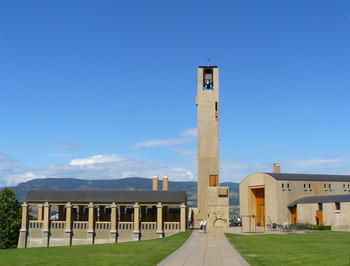 Indeed the road to Mission Hill, mixes new, upscale housing developments and vineyards to a startling degree. The campus itself (designed by Seattle architect Tom Kundig) is a showpiece, like an Italian village square or cloister, with a 12-story campanile (bell tower), colonnaded loggia overlooking the lake, terrace restaurant (more columns), amphitheater, and a church-like space that houses a tapestry by Matisse. The winery's barrels are housed underground. The restaurant, with stunning lake and vineyard views, was named one of the world's six top "winery restaurants" by Travel & Leisure.
Indeed the road to Mission Hill, mixes new, upscale housing developments and vineyards to a startling degree. The campus itself (designed by Seattle architect Tom Kundig) is a showpiece, like an Italian village square or cloister, with a 12-story campanile (bell tower), colonnaded loggia overlooking the lake, terrace restaurant (more columns), amphitheater, and a church-like space that houses a tapestry by Matisse. The winery's barrels are housed underground. The restaurant, with stunning lake and vineyard views, was named one of the world's six top "winery restaurants" by Travel & Leisure.
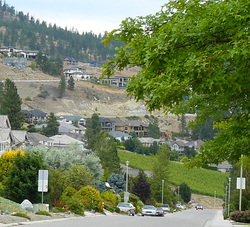 Rhys Pender, an Australian Master of Wine with a consulting business among the Okanagan's wineries, advises his clients, "Don't aim for the middle. Aim high."
Rhys Pender, an Australian Master of Wine with a consulting business among the Okanagan's wineries, advises his clients, "Don't aim for the middle. Aim high."
Comparing Okanagan wines today to Washington makes the same (misguided) assumptions that governed the Washington-to-California comparisons two decades ago, or California-to-France two decades before that. The vineyards are still young, the vines immature, the growers and winemakers inexperienced.
If there's one thing we've learned, it's that vineyards, vines, and winemakers continue to grow and mature. "Wine quality in the Okanagan will continue to improve with increased knowledge, clone selection, and age of vines," says Allen Shoup, who led Chateau Ste. Michelle through its period of adolescence to maturity. "What they have in the Okanagan is unique. And Anthony von Mandl's vision and aesthetic tastes have all but assured the region a charmed future."
If you go: The harvest-season Okanagan Wine Festival takes place September 29th through October 9th. For more information, visit www.thewinefestivals.com. It's a six-hour, 300-mile drive from Seattle to the Okanagan wine country. Horizon Air has two non-stop flights a day from Seattle to Kelowna.
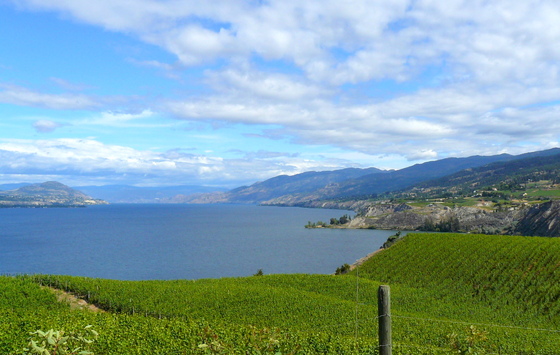
Leave a comment